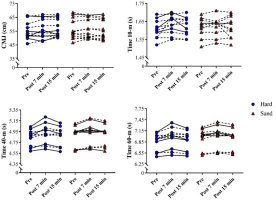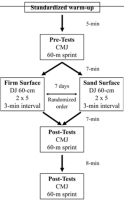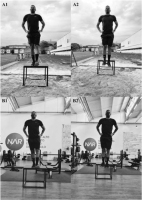Introduction
Performance improvements obtained immediately after a conditioning activity (CA) have recently been termed as “post-activation performance enhancement” (PAPE) (Boullosa, 2021; Boullosa et al., 2020b). In more applied settings, PAPE is one of the main goals of warm-up strategies and the rationale behind the use of complex and contrast training methods (Boullosa, 2021; Derenne, 2010; Marshall et al., 2021). Inducing PAPE becomes especially important in sports involving short and explosive actions such as track and field sprinting, jumping, and throwing, where PAPE can be more clearly justified and related to successful performance outcomes (Boullosa et al., 2020a; Loturco et al., 2015, 2020; Zimmermann et al., 2021).
During sprint events (e.g., 100-m dash), minimal differences in performance are of paramount importance. The regular variation observed between world-class sprinters during official 100-m races is ~1%, and throughout their professional career, differences between their fastest and slowest times are ~3% (Hopkins, 2004; Loturco et al., 2020). For example, when considering the men’s 100-m final at the last Olympic Games (Tokyo 2020), the time-difference between the Olympic champion and the fourth place was equal to 0.13s (IAAF, 2021). Theoretically, if the competition occurred again under similar circumstances, there would be a high chance of changes in medal positions. Thus, implementing effective warm-up exercises able to acutely induce small (but meaningful) performance enhancements in top-level sprinters is extremely relevant for athletes and coaches.
The effects of PAPE on sprint performance have been investigated in non-elite sprinters (e.g., young and state level athletes) with the use of both resistance and plyometric exercises (e.g., half-squat and drop-jump [DJ]) as a CA (Bonfim-Lima et al., 2011; Dechechi et al., 2013). However, there is a lack of studies examining this phenomenon in elite sprinters whose margins for performance improvements are extremely reduced. Besides the exercise mode and intensity, several other factors may influence PAPE responses, especially in highly-trained subjects (Impellizzeri et al., 2008; Rhea, 2004). For instance, the mechanical properties of landing surfaces can play a critical role when programming and prescribing ballistic and reactive movements such as DJs (Pereira et al., 2021). Although jumping on “hard surfaces” (e.g., vinyl or wood) increases the capacity of muscles to store and reuse elastic energy, movements on “soft surfaces” (e.g., sand) usually have a higher energy cost and can lead to greater muscle activation (Pereira et al., 2021). Somewhat surprisingly, a recent systematic review addressed this issue and revealed that both hard and sand surfaces were equally efficient to chronically improve measures of athletic performance (Pereira et al., 2021). Notably, when it comes to PAPE responses, there is no literature examining which type of the surface is able to promote greater acute increases in both sprinting and jumping abilities following ballistic exercises. This is particularly important to sprint coaches who are always searching for effective strategies to improve, even minimally, competitive performance of their athletes. Therefore, this study aimed to compare PAPE responses induced by successive DJs executed on hard and sand surfaces in sprint and jump performance of top-level sprinters.
Methods
Participants
Twelve male sprinters (25.3±2.6 years; 184.9±0.59cm; 81.0±5.9kg) took part in this study. Athletes were regularly involved in 5-6 training sessions per week comprising maximal and submaximal sprints, resisted sprints, technical sprint drills (e.g., skipping and high-knee runs), strength-power training, and plyometrics, and had at least 6 years of experience in competitive track and field. The sample comprised two athletes who participated in the last edition of the Olympic Games (Tokyo 2020) and the other athletes were regularly involved in national and international competitions, with 100-m personal best times ranging from 10.10 to 11.17-s. Prior to participating in this study, athletes signed an informed consent form. The study was approved by the local Ethics Committee.
Study Design
This randomized cross over study evaluated the PAPE responses of two distinct CAs on jump and sprint performance of top-level sprinters. The study design is described in Figure 1. Athletes visited our facilities on two occasions. On each testing session, which was completed at the same time of the day (from 9:00 to 10:00 a.m.), they were allocated to the experimental protocols (Figure 2) in randomized order. Participants were familiarized with testing procedures and both CA protocols and were required to avoid caffeine and alcohol consumption for 24h before the procedures. The intervention was conducted during the competitive phase of the season. Prior to pre-tests, sprinters performed a standardized warm-up which was mimicked in both experimental conditions. The warm-up consisted of running at a moderate pace (rating of perceived exertion of 3-4 in a 10 point scale, Foster et al., 2001) for 10-min followed by five min of dynamic stretching exercises, three submaximal vertical jump trials, and two submaximal sprints (~70% of maximal sprint velocity) interspersed by two min of passive recovery.
Procedures
Vertical Jump Test
Vertical jumping height was assessed using the countermovement jump (CMJ). Athletes started from a standing position and were instructed to perform a downward movement followed by complete extension of the lower limbs and the amplitude of the countermovement was freely determined to avoid changes in the jumping coordination pattern. All jumps were executed with the hands on the hips. A total of three trials were allowed, interspersed by 15-s intervals. Jump tests were performed on a contact mat (Elite Jump®, S2 Sports, São Paulo, Brazil) and the best attempt was considered for analysis.
60-m Sprint Performance
Four pairs of photocells (Smart Speed, Fusion Equipment, Brisbane, AUS) were positioned at the starting line and at the distances of 10, 40, and 60-m along the sprinting course. Athletes started the sprint 0.5-m behind the starting line. The tests were performed on an indoor running track and athletes sprinted wearing their own track spikes.
Statistical Analyses
After checking the normality of data, differences between time periods and conditions (i.e., sand surface versus vinyl surface) were assessed using a two-way analysis of variance with repeated measures. The level of significance was set at p<0.05. Effect sizes (ES) (Cohen, 1988) along with their 95% confidence intervals (CI) were also calculated to determine the magnitude of the differences between variables. The ES were interpreted using the thresholds proposed by Rhea (2004) for highly trained subjects as follows: <0.25, 0.25–0.50, 0.50–1.00, and >1.00 for trivial, small, moderate, and large, respectively. Absolute and relative reliability was assessed using the coefficient of variation (CV) and a two-way random intraclass correlation coefficient (ICC), respectively. Percentage change was calculated for all variables and subsequently compared to CV values to determine whether changes in speed and jump performances were greater than the test variance, thus providing an indication of whether true change occurred for each sprinter (Bishop et al., 2021).
Results
Table 1 shows reliability data and comparisons of vertical jump heights and sprint times between both surfaces at different time periods. No significant differences were observed for any variables in any PAPE condition or distance range. Figure 3 displays individual pre-, 7-min post-, and 15-min post-CA for CMJ and sprinting performances. Sprinters who showed percentage changes greater than the CV values (i.e., “true change”) are identified by dashed lines, whilst the solid lines represent percentage changes lower than the CV.
Figure 3
Individual variations in countermovement jump (CMJ) height and sprint times over different distances. Dashed lines indicate % changes higher than the CV values; solid lines indicate % changes lower than the CV values.

Table 1
Comparisons of vertical jump heights and sprint times on both sand and hard surfaces over the distinct resting times.
Discussion
We compared the PAPE responses induced by successive DJs executed on hard (i.e., vinyl) and sand surfaces in sprint and jump performance of top-level sprinters. Overall, no differences in jump height or sprinting times were observed, regardless of the surface used during the CA. In addition, these findings may suggest that top-level sprinters (including Olympic athletes) are less susceptible to PAPE effects than their less qualified peers (i.e., national level sprinters) (Bonfim-Lima et al., 2011; Dechechi et al., 2013; Zimmermann et al., 2021).
Our results are in agreement with those observed in other studies conducted with academy soccer players (Till and Cooke, 2009) and plyometric-trained subjects, in which different jump types (i.e., tuck jumps and alternate leg bounding) were not capable of inducing PAPE. On the other hand, young handball players (Dello Iacono et al., 2016) and national level sprinters (Bonfim-Lima et al., 2011; Zimmermann et al., 2021) exhibited acute increases in both sprint and jump performance after performing a series of DJs or countermovement jumps. Although it is not possible to compare our data with those obtained in previous investigations, it could be inferred that: 1) despite the confirmed efficiency of the DJ as a CA, top-level sprinters are “non-responders” (Wilson et al., 2013) to certain potentiation protocols; and 2) the volume and intensity of the CA (number of repetitions and drop-height of the DJ) used in this study were not sufficient to trigger PAPE in these highly specialized track and field athletes. However, it is important to emphasize that our protocol was carefully chosen to fit with the current literature and sprinters’ training routines (Bonfim-Lima et al., 2011; Dello Iacono et al., 2016; Wilson et al., 2013). As such, further research is needed before any definitive conclusion can be drawn.
The potentiation strategy implemented in the current work is similar to that implemented by Bonfim-Lima et al. (2011) and considered the variables (i.e., rest intervals, number of sets, and exercise type) which usually elicit greater PAPE effects, as described in a previous meta-analysis (Wilson et al., 2013). Nonetheless, even adopting a “hypothetically effective protocol”, top-level sprinters did not experience PAPE and demonstrated a high inter-individual variation in their responses after the CAs (Figure 3). In this sense, a recent study has revealed that highly trained subjects may present extremely divergent responses to similar CAs (Kobal et al., 2019). Accordingly, it has been argued that acute PAPE responses may be very individual, making it difficult to configure and establish standardized CA protocols (Kobal et al., 2019; Wilson et al., 2013). Thus, even when dealing with homogeneous groups of elite athletes, the current results indicate that potentiation protocols should be individually tested and tailored in order to promote significant PAPE effects.
This study is the first to compare the effects of two distinct landing surfaces when prescribing DJs as a CA. The effectiveness of training on sand in the speed and power-related performance of athletes from various sports was confirmed in a recent meta-analysis (Pereira et al., 2021). In that review, it was concluded that hard and sand surfaces were equally effective for chronically improving sprint and jump abilities, despite the critical differences in their mechanical properties (i.e., high elastic energy restoration versus high elastic energy absorption capacities) (Pereira et al., 2021). Here we demonstrated that these mechanical differences were also unable to elicit different PAPE responses, at least in a sample composed of top-level sprinters. For this population, higher or lower levels of elastic energy dissipation during the execution of successive DJs appear to have similar “non-effects” on acute sprint and jump performance. This is an important finding, since it has been previously shown that training on sand induces lower levels of muscle soreness compared to harder surfaces (Impellizzeri et al., 2008; Miyama and Nosaka, 2004), which can be a great advantage for professional athletes during periods of intense training. Hence, aside from the inefficiency of both CAs, track and field coaches may also consider using sand training interventions (e.g., short-plyometric training sessions or warm-up routines on sand) even immediately before sprint-specific training, especially close to competitions. The proven effectiveness of sand training associated with this “potential benefit” may support and encourage the use of this practical and safe training strategy (Pereira et al., 2021).
This study is limited by the lack of a “control condition” (i.e., an experimental group of athletes who did not execute any type of the CA). In addition, we did not assess sprinters in intervals < 7 minutes (i.e., time between CAs and subsequent performance measurements), being not possible to examine the occurrence of PAPE after shorter periods of time (e.g., 2 or 4 minutes). Nevertheless, the research was conducted with professional athletes during the competitive period, which greatly limited the treatment options. Lastly, the use of a highly specialized sample of top-level sprinters precludes the extrapolation of our results to other athletic populations.
Conclusions
Successive DJs executed on sand and hard surfaces were not capable of acutely enhancing or impairing the sprint and jump performance of top-level sprinters. Track and field coaches may prescribe short-plyometric training sessions and warm-up exercises on sand surfaces even close to competitions, bearing in mind that this strategy will not compromise the competitive performance of their sprinters.




